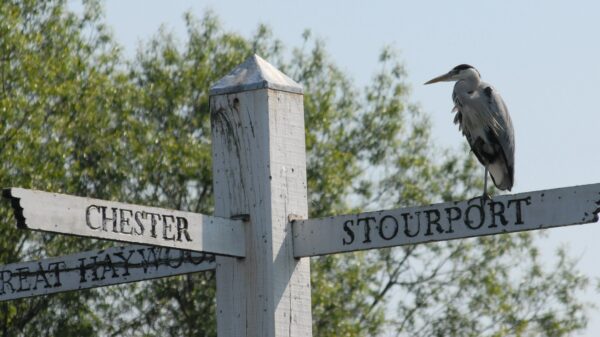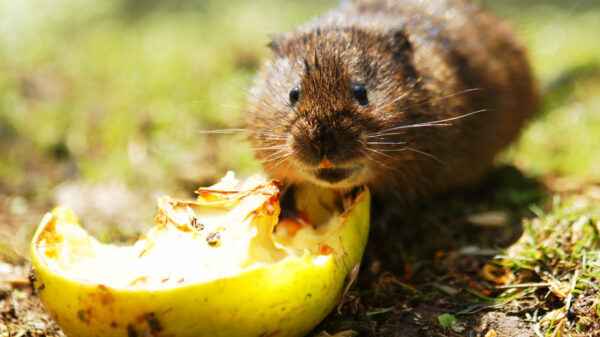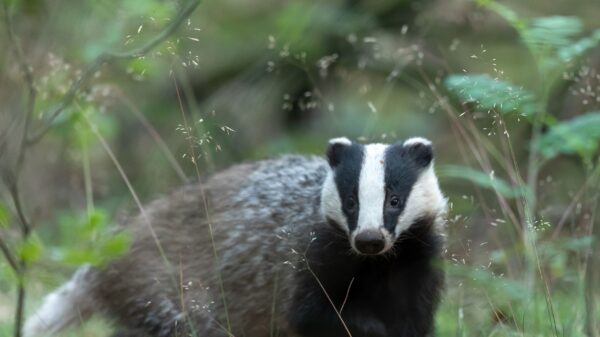Restoration Hub > Environmental Toolkit > Protected Species: Badger
Restoration Hub
Protected Species: Badger
About
The European badger (Meles meles) is a characteristic mammal most commonly associated with the British countryside. Although a common species within the UK, badgers remain secretive and hidden throughout much of the day, opting to emerge from their setts during the evening and at night. Badgers are omnivores and will eat a variety of foods; with much of their diet consisting of earthworms, but are also known to also eat slugs, rodents, frogs, cereals, fruits, nuts and grubs. The weight of badgers varies with the seasons being 7-13kg in spring and getting up to the region of 15-17kg in autumn prior to the less active winter months. Badgers live in social groups of up to 14 adults and reside within setts (a series of underground tunnels and chambers) often located on slopes and in sheltered positions. Badgers occupy a large range of habitat types ranging from woods, and copses, to scrub, hedgerows and open fields, they are most abundant in areas with a good mix of habitats; though they can also be found around urban areas and housing developments.
Why are Badgers protected?
In the past badgers have been persecuted, leading to a major decline in their population. The Protection of Badgers Act (1992) was introduced in order to protect this species from intentional; cruelty such as baiting, poisoning, sett interference and snaring. The act also protects badgers from legal activities such as road and housing developments, forestry and agricultural operations and also ensuring that badger culling is permitted only after appropriate exemptions and been classified.
Protection Status
Badgers are protected under The Protection of Badgers Act (1992). This means that “It makes it an offence to kill, injure or take a badger from the wild. It is also an offence to damage or interfere with a sett unless a licence is obtained from a statutory authority”. The maximum sentence is up to six months imprisonment and or a fine of £5000 (the fine can be multiplied depending on number of badgers affected) and the destruction/disposal of a dog that has been used to enter a badger sett.
Identifying badgers
Physical features and signs
Badgers are very easily identifiable with distinct black and white striped head and grey fur. The average adult will measure in at about 75cm (30in), with a small head and eyes, a thick short neck and a long wedge shaped body. However due to their nocturnal lifestyle and shyness around people they can be a rare sight despite their relative abundance. Often it is equally important in being able to identify the signs of badgers to assess their presence:
- Setts: generally built on slopes and embankments where the soil is generally well drained. The setts can range from a single entrance to multiple entrances leading into underground complexes. Sett entrances can vary in size but generally they measure at about 30cm at the bottom width and a height of around 20cm. An obvious tell-tale sign of an active badger sett is excavated soil outside the entrances.
- Latrines: shallow holes called ‘dung pits’ re used for defecation purposes, with a collection of these making a latrine. Commonly these are found near feeding sites or near to the main setts.
- Paths: Badgers are creatures of habit and will use the same musk-scented trails that their ancestors before them used. The paths are usually be a muddy trail through woodlands and grasslands to feeding sites, often getting less obvious the further away from their setts.
- Hair and prints: badger hair is distinctive, when compared to other UK mammals such as the fox and rabbit. Dirty with a silver top and dark band, generally the hair is 70mm in length with an oval cross section. If rubbed between fingertips the hair feels course and wiry. Badger prints can also be used to distinguish identify the species, they have five claws and a large wedge shaped central pad, these may be more difficult to identify if not fresh.
- Scratching trees: Scratch marks can be found on trees and dead wood near setts (often on elder), with vertical marks extending through to the base. The reason for these ranges from territorial markers, to claw maintenance and stretching after a day underground.
To find out more about identification visit the Badger Trust website
Badgers and Canal Restoration
With an estimated 288,000 badgers in the UK, it isn’t surprising to find badgers living alongside our active and derelict waterways. Setts can be found in embankments or cuttings; these provide optimal conditions for digging. Rural canals and navigations also provide a mosaic of habitats ideal for badger ecology. Depending on available habitat, landscape features, abundance of badgers, ecological corridors and food, the size of the home range can vary from 30 hectares in an optimum habitat to as large as 300 hectares in a poor habitat.
Restoring Waterways
If the presence of badgers is known or is thought to be located near a proposed canal restoration site, then prior to restoration, destruction or building work, a badger survey should be part of the planning application, especially if the works could potentially affect the badgers. If it is deemed that badgers would be affected by the works a mitigation plan should be submitted to the planning authority and a licence acquired from the appropriate Statutory Nature Conservation Organization (SNCO). Depending on the necessity of works, mitigation options provided and whether the work would actually affect badgers, work would be either permitted or sent back to planning.
Examples of activates that may require a licence are:
- Using heavy machinery within 30m of an active badger sett entrance.
- Using light machinery particularly digging within 20m of active badger sett entrance.
- Using hand tools or carrying out other lighter tasks such as scrub clearance within 10m of active badger sett entrance.
Active Sett?
It can be difficult to determine whether a sett is active, especially in winter months where activity is at its lowest. The best indication of an active sett is recently excavated materials into a mound nearby the sett entrance. Generally speaking an active sett is also well maintained, for example a sett entrance in summer with an excess of fallen foliage, twigs and other materials could indicate that this entrance is not in face being used. Other indicators includes fur, prints and paths.
More detailed information can be found on the Badger Trust website.
Our use of cookies
We use necessary cookies to make our site work. We'd also like to set optional analytics cookies to help us improve it. For more detailed information about the cookies we use, see our 'Cookie Policy page'.Edit preferences Accept
Privacy Overview
| Cookie | Duration | Description |
|---|---|---|
| __stripe_mid | 1 year | Stripe sets this cookie to process payments. |
| __stripe_sid | 30 minutes | Stripe sets this cookie to process payments. |
| cookielawinfo-checkbox-advertisement | 1 year | Set by the GDPR Cookie Consent plugin, this cookie records the user consent for the cookies in the "Advertisement" category. |
| cookielawinfo-checkbox-analytics | 1 year | Set by the GDPR Cookie Consent plugin, this cookie records the user consent for the cookies in the "Analytics" category. |
| cookielawinfo-checkbox-functional | 1 year | The GDPR Cookie Consent plugin sets the cookie to record the user consent for the cookies in the category "Functional". |
| cookielawinfo-checkbox-necessary | 1 year | Set by the GDPR Cookie Consent plugin, this cookie records the user consent for the cookies in the "Necessary" category. |
| cookielawinfo-checkbox-others | 1 year | Set by the GDPR Cookie Consent plugin, this cookie stores user consent for cookies in the category "Others". |
| cookielawinfo-checkbox-performance | 1 year | Set by the GDPR Cookie Consent plugin, this cookie stores the user consent for cookies in the category "Performance". |
| CookieLawInfoConsent | 1 year | CookieYes sets this cookie to record the default button state of the corresponding category and the status of CCPA. It works only in coordination with the primary cookie. |
| PHPSESSID | session | This cookie is native to PHP applications. The cookie stores and identifies a user's unique session ID to manage user sessions on the website. The cookie is a session cookie and will be deleted when all the browser windows are closed. |
| Cookie | Duration | Description |
|---|---|---|
| _fbp | 3 months | Facebook sets this cookie to display advertisements when either on Facebook or on a digital platform powered by Facebook advertising after visiting the website. |
| _ga | 1 year 1 month 4 days | Google Analytics sets this cookie to calculate visitor, session and campaign data and track site usage for the site's analytics report. The cookie stores information anonymously and assigns a randomly generated number to recognise unique visitors. |
| _ga_* | 1 year 1 month 4 days | Google Analytics sets this cookie to store and count page views. |
| _gat_gtag_UA_* | 1 minute | Google Analytics sets this cookie to store a unique user ID. |
| _gat_UA-* | 1 minute | Google Analytics sets this cookie for user behaviour tracking.n |
| _gid | 1 day | Google Analytics sets this cookie to store information on how visitors use a website while also creating an analytics report of the website's performance. Some of the collected data includes the number of visitors, their source, and the pages they visit anonymously. |
| CONSENT | 2 years | YouTube sets this cookie via embedded YouTube videos and registers anonymous statistical data. |
| Cookie | Duration | Description |
|---|---|---|
| test_cookie | 15 minutes | doubleclick.net sets this cookie to determine if the user's browser supports cookies. |
| VISITOR_INFO1_LIVE | 5 months 27 days | YouTube sets this cookie to measure bandwidth, determining whether the user gets the new or old player interface. |
| YSC | session | Youtube sets this cookie to track the views of embedded videos on Youtube pages. |
| yt-remote-connected-devices | never | YouTube sets this cookie to store the user's video preferences using embedded YouTube videos. |
| yt-remote-device-id | never | YouTube sets this cookie to store the user's video preferences using embedded YouTube videos. |
| yt.innertube::nextId | never | YouTube sets this cookie to register a unique ID to store data on what videos from YouTube the user has seen. |
| yt.innertube::requests | never | YouTube sets this cookie to register a unique ID to store data on what videos from YouTube the user has seen. |






